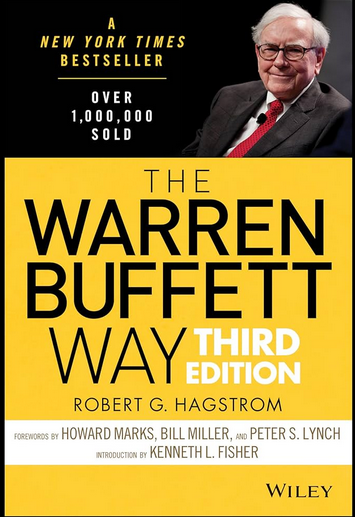“The Warren Buffett Way,” De-mystified: Quality First, Price Second, Ego Nowhere
Real argument: Own a few outstanding businesses at sensible prices, run by rational capital allocators, and hold for years—don’t trade stories or charts. Verdict: Read for a durable filter and case-study clarity; skip if you want factor screens, macro calls, or excitement.
BOOKS
10/6/20255 min read


The Big Idea
This book distills a simple but strict stance: buy wonderful businesses at fair prices, not fair businesses at wonderful prices. Filter by business quality first (moat, returns on capital, reinvestment prospects), people second (owner-like managers), and price third (margin of safety). Then sit still while compounding does the heavy lifting. The text aims to convert Buffett’s letters and moves into a replicable checklist—not a trading system.
What’s New Here (and Why It Matters)
Plenty of books quote Buffett. This one is more useful because it reverse-engineers actual decisions (consumer brands, insurers, capital-light compounding machines) into tenets you can apply. You learn to evaluate economics before valuation: understand how a business makes money and where that money can go next, or don’t touch it. Comparators were not provided.
Core Arguments / Plot Architecture (spoiler-safe)
Structure:
Philosophy: markets as voting vs. weighing machine; temperament over IQ.
Business Tenets: simplicity, moat, predictability, unit economics.
Management Tenets: candor, rational capital allocation, skin in the game.
Financial Tenets: high ROIC, strong free cash flow, modest leverage.
Value Tenets: intrinsic value, margin of safety, focus/concentration.
Case Studies: how the filter explained past Berkshire-style buys and passes.
Evidence style: Narrative + accounting snapshots; no fancy statistics, just business logic.
Deep Dive
Frameworks & Models
Circle of Competence:
Use: Write (in a sentence) how the firm makes money and why it lasts. If you can’t, it’s outside your circle—pass.
Moat → Economics → Reinvestment:
Use: Score 0–2 on each: (a) moat durability, (b) current ROIC vs. cost of capital, (c) reinvestment runway. Only 5–6/6 earns deep work on price.
Owner Mentality Check:
Use: Read 5 years of letters/filings. Has management repurchased when cheap, issued when dear, avoided diworsification, and been candid about mistakes?
Look-Through Earnings:
Use: Normalize earnings to cash, subtract maintenance capex, add back hidden interests (equity affiliates). Value the stream, not GAAP noise.
Margin of Safety (MOS):
Use: Build a conservative DCF or multiples triangulation. Demand a 25–40% MOS to cover model and judgment errors.
Focus Investing:
Use: Fewer, bigger bets when conviction is earned. Tie position size to downside if wrong, not just upside if right.
Evidence Check
Strengths: The business-first filter beats style drift; unit economics + reinvestment predict long-run compounding better than P/E tourism. The book’s case studies make abstract ideas concrete.
Weaknesses: Survivorship bias lurks—winners get airtime; losers get less. Some lessons depend on Berkshire’s structural edges (float, reputation, deal flow, tax). Back-tests are light; execution skill and patience are under-taught.
Assumptions Under the Hood
Public accounts reflect economic reality closely enough to judge quality.
You can hold through volatility and resist benchmark FOMO.
Rational capital allocation will continue under stable incentives.
Inflation/regime shifts won’t permanently break moats you’re betting on.
If these wobble, the checklist still helps—but your confidence interval widens.
Practical Takeaways
Invert the workflow: Study the business model first, valuation last. If reinvestment is capped, demand a much lower entry price.
Underwrite managers: Treat buybacks, M&A, and disclosure quality as data. Set a red-flag list (empire building, stock-comp bloat, adjusted EBITDA theater).
Own fewer names: Concentrate only where you can articulate the moat and the bear case better than the bull case.
Quit the ticker: Move monitoring to quarterly unless the thesis changes. Price alerts are not thesis updates.
Respect taxes: Holding periods matter. A 20% gain deferred for 5–10 years can outperform faster churn after tax.
Avoid narrative traps: If the moat depends on regulatory grace or hype, model the reversion explicitly.
Size by downside: Use scenario analysis. Size so that a bad case doesn’t blow up the portfolio.
Micro-Checklist (print this)
Moat and durability (plain English).
5-year ROIC vs. cost of capital (direction, not false precision).
Reinvestment runway (organic + M&A, with constraints).
Capital allocation record (buybacks, debt, deals, candor).
Intrinsic value range + MOS ≥ 25%.
Clear exit rules (thesis break, better idea, or egregious valuation).
Contrarian Note
The book implies concentration is a free lunch if you’ve done the work. Reality: even great businesses face exogenous shocks (policy, tech, fraud). Concentration is a bet against unknown unknowns. For most investors, a barbell works better: 5–10 high-conviction names plus a low-cost index core to cap tail risk.
Blind Spots & Risks
Float envy: Berkshire’s low-cost float is not replicable for retail investors. Don’t reach for leverage to mimic it.
Quality bubbles: When “moat” becomes a crowd trade, quality gets overpriced. The method needs the discipline to say no for years.
Accounting drift: Intangible-heavy businesses can mask economic erosion behind GAAP quirks; the book’s classic ROIC lens needs modern tweaks.
Selection bias: Case studies teach pattern recognition and overconfidence. Log misses as carefully as hits.
Who Should Read This (and Who Shouldn’t)
Read if:
You’re building a concentrated, long-only portfolio with multi-year horizons.
You enjoy reading filings and thinking like an owner.
You want a repeatable filter, not guru worship.
Skip if:
You trade momentum, macro themes, or options as a primary edge.
You can’t hold through 30–50% drawdowns in great names.
You want an autopilot screen—this is judgment-heavy.
How to Read It
Pacing: Two weekends. Build your own checklist alongside.
Skim vs. slow down: Skim the origin stories; slow down on the tenets and the valuation logic.
Format: Print/ebook for margin notes; keep a spreadsheet open for ROIC and MOS sketches.
Follow-on: Pair with primary sources (company filings) to test the tenets on a live name.
Scorecard (1–10)
Originality: 6 — Classic ideas, cleanly organized for application.
Rigor / Craft: 7 — Sound business logic; limited statistical testing.
Clarity: 9 — Plain English; checklists beat mystique.
Usefulness: 8 — High if you actually build and use the filter.
Re-read Value: 8 — Good seasonal reset when you drift toward noise.
If You Liked This, Try…
The Intelligent Investor (Benjamin Graham): Margin-of-safety roots; drier, deeper on valuation discipline.
Common Stocks and Uncommon Profits (Philip Fisher): Scuttlebutt and management quality—pairs with the “people” tenets.
Poor Charlie’s Almanack (Charles T. Munger): Mental models and quality at a fair price philosophy.
Quality Investing (Pat Dorsey et al.): Modern moat patterns and capital allocation signals.
100 Baggers (Christopher Mayer): Reinvestment and time—what compounding monsters share.
FAQ
Can a retail investor really follow this?
Yes—minus float and deal access. Focus on public moats, long holding periods, and tax efficiency.
How many stocks should I own?
Enough to sleep—often 8–15 for a focused strategy, plus a core index if you’re human.
What’s the biggest mistake readers make?
Confusing brand heat with moat and paying up for growth without runway or returns.
How do I know when to sell?
When the thesis breaks, a better business appears, or price exceeds upper intrinsic value with no reinvestment optionality.
Is this style dead in an AI/zero-rate/re-rate world?
No. Economic moats and rational allocation don’t expire; just update how you measure intangible-heavy quality.
Final Verdict
This book is a filter, not a formula. If you can think like an owner, ignore carnival noise, and accept boredom as a feature, it’s worth your shelf space. Adopt the business-quality → people → price sequence, size for downside, and respect taxes and time. If you want adrenaline or macro prophecies, borrow it and move on. Compounding is quiet; your process should be too.




